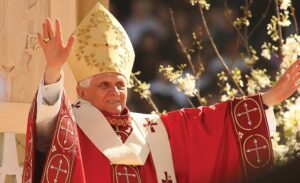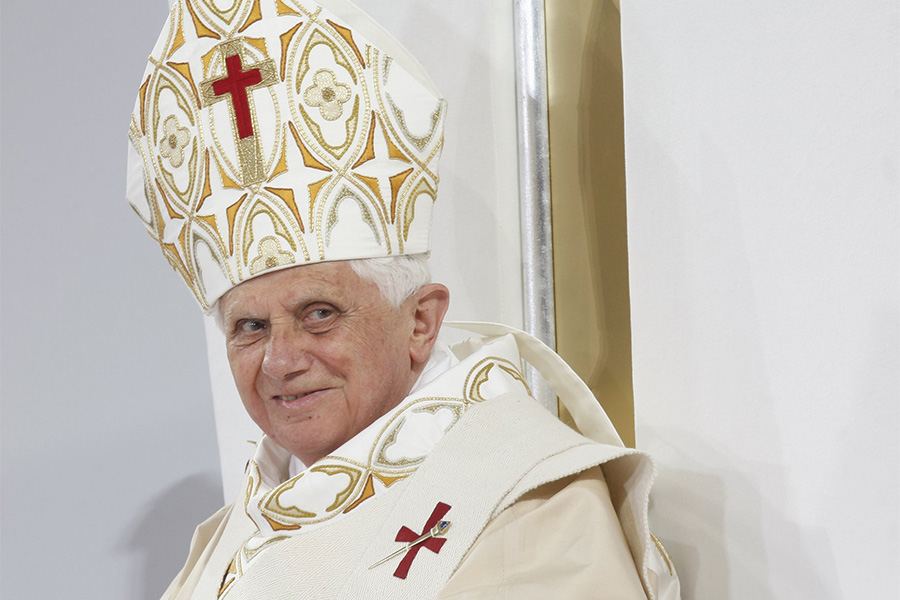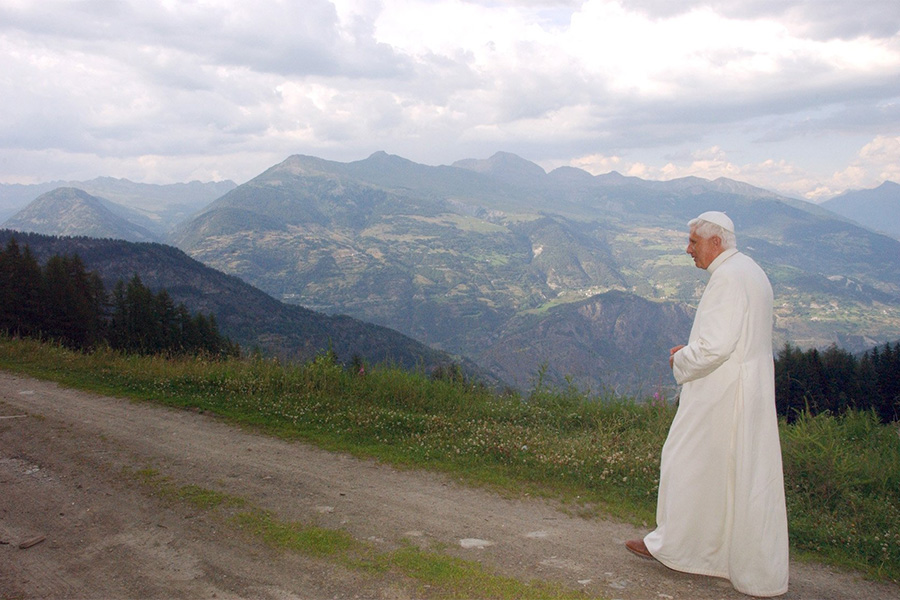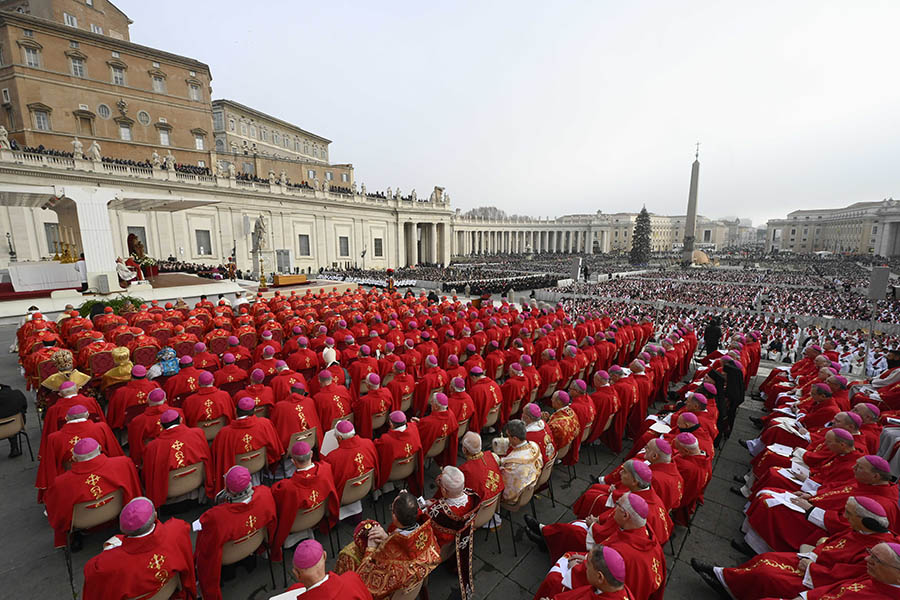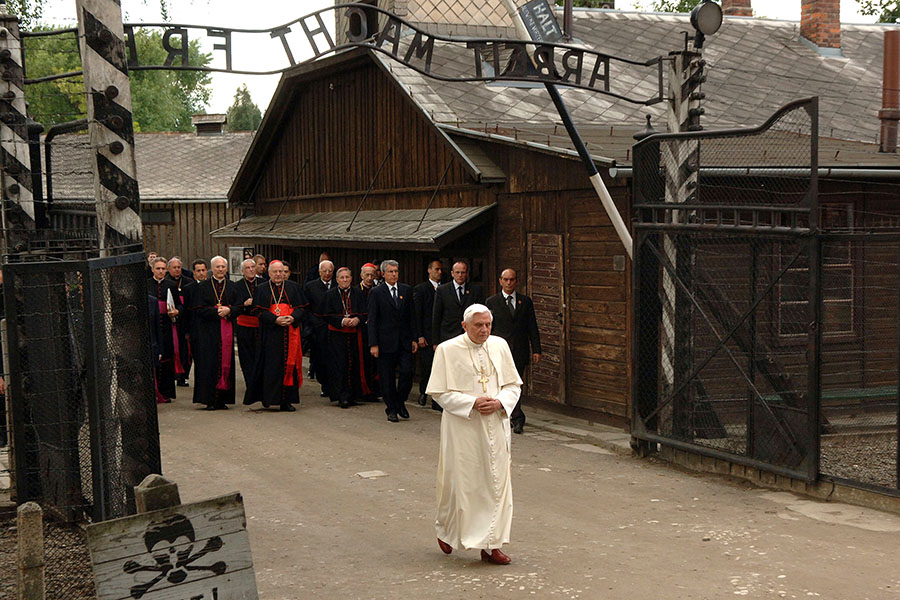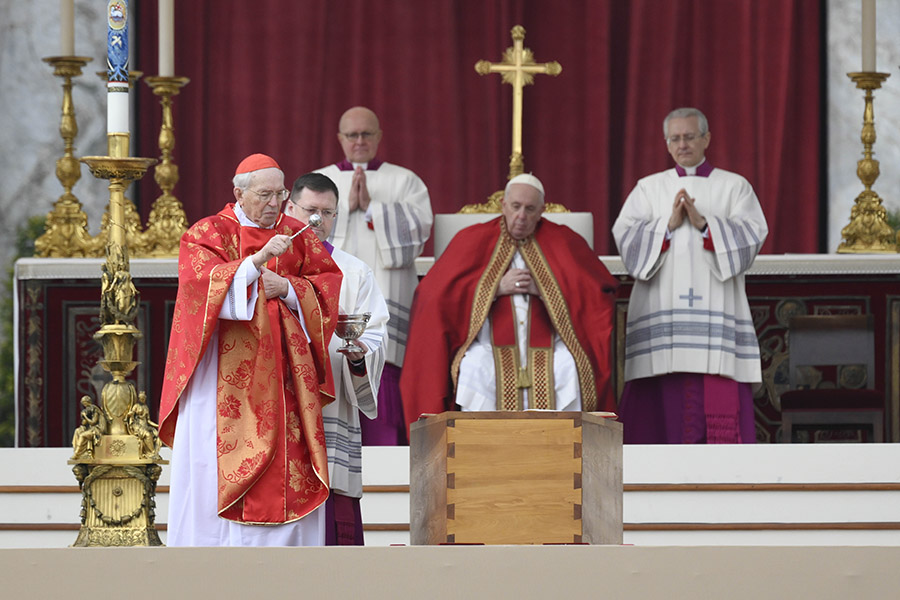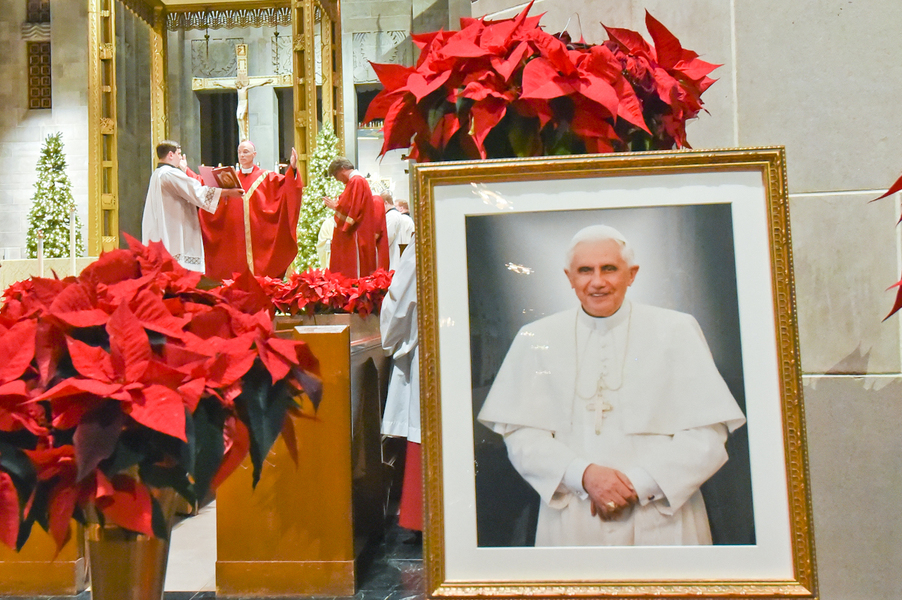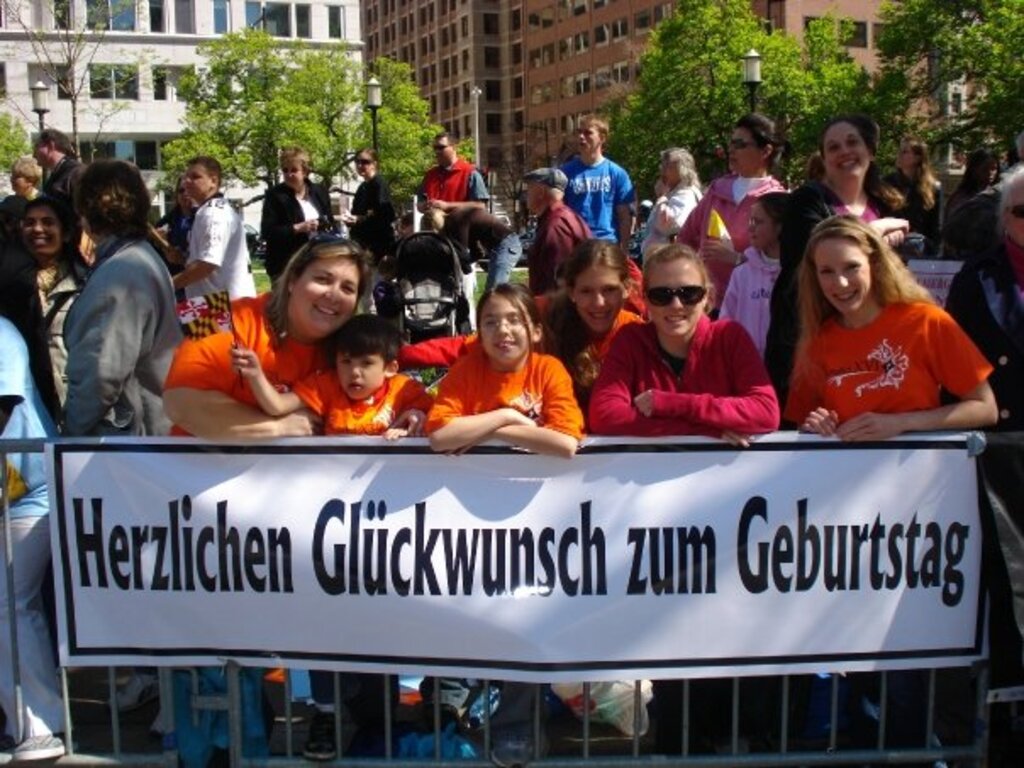
When Pope Benedict XVI entered the Basilica of St. Paul’s Outside the Walls in Rome for a special 2008 liturgy unveiling the Year of St. Paul, Ginny Dauses was overcome with excitement.
“I love you, Papa!” Dauses screamed at the top of her lungs.
The pope approached the young American, who was then serving as campus minister at St. Mary’s High School in Annapolis.
“He looked right at me, as though he recognized me,” Dauses remembered. “He held my hands, put a hand on my head and prayed silently for what seemed like 10 minutes, but was only about four. I was bawling, and he tapped the side of my face.”
Dauses was in Rome with a group of pilgrims from the Archdiocese of Baltimore for the conferral of the pallium on then-Archbishop Edwin F. O’Brien. The encounter was one of the highlights of her life, she said.
“He was a wise, understanding, holy man,” said Dauses, who led groups of young people to the 2005 World Youth Day in Cologne, Germany, and the 2011 World Youth Day in Madrid, Spain, both attended by Pope Benedict. She was also with young people during the pope’s 2008 visit to New York and Washington, D.C., where a youth from her group came up with the idea of wearing t-shirts emblazoned with “Papa-Rattzi.”
“(Benedict) was a brilliant theologian and had an amazing ability to speak clearly at the level of the teens,” she said. “He was joyful and loving – and the kids picked up on that. Even though he was older than they were, they really related to him.”
Dauses was among many Catholics in the Archdiocese of Baltimore who had firsthand experiences with the late pope emeritus, who died Dec. 31. Though they mourn a man who led more than 1 billion Catholics, they see his legacy as long-lasting.
‘On the right path’
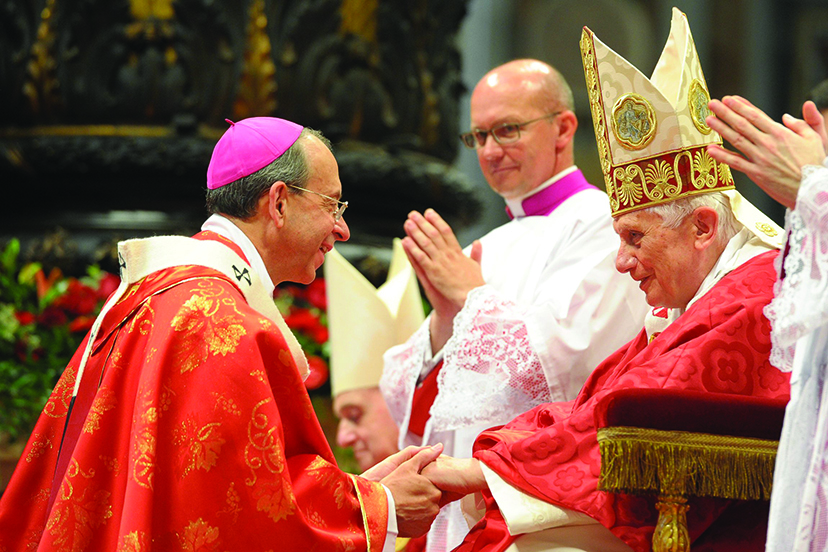
Father Michael DeAscanis, pastor of the pastorate of St. Louis in Clarksville and St. Francis of Assisi in Fulton, keeps one of his most prized possessions hanging on his wall.
The framed booklet with the Mass readings from the Feast of St. Leo in 2001 in Rome bears the autograph of then-Cardinal Joseph Ratzinger, the future Pope Benedict. Father DeAscanis asked the German cardinal to sign the booklet after Father DeAscanis served Mass for the cardinal at the special liturgy at St. Peter’s Basilica.
At the time, Father DeAscanis was a seminarian studying at the Pontifical North American College in Rome. He and other seminarians had studied the books of Cardinal Ratzinger, prefect of the Congregation for the Doctrine of the Faith.
“That was part of our formation,” Father DeAscanis said, “so we very much appreciated his insights. To be able to pray Mass with him was very special.”
Father DeAscanis said Pope Benedict’s writings on the Mass, especially about the continuity between the “old” Latin Mass and the “new” Mass, were influential on his priesthood. The pope showed how everything in the church must be rooted in Scripture and the church fathers, he said.
“As long as we are grounded in Scripture and patristics, we’re always on the right path,” Father DeAscanis said. “If you hear ideas which sound interesting and novel, but you’re not sure they’re right, well, are they in the Scripture? Are they in patristics? If not, then it’s probably not the right way to go.”
As a seminarian, Father DeAscanis said, “that gave me a clarity as I moved forward and judged what’s going on in the Church or what ideas people are proposing.”
Father DeAscanis recalled serving as a deacon for the 2003 Christmas midnight Mass with St. John Paul II at St. Peter’s Basilica. At a certain point in the Mass, the Baltimore deacon had to step forward to elevate the chalice.
“I nudged Cardinal Ratzinger out of the way,” Father DeAscanis recalled with a laugh. “It was one of those surreal moments.”
Charity and clarity

Peter’s Basilica in Rome Feb.
19, 2012. Cardinal Edwin F. O’Brien had surprised her and another member of her religious community with the honor of receiving Communion from the pope. (Christopher Gunty/CR Staff)
The All Saints Sisters of the Poor, a community of Anglican nuns in Catonsville who were received into the Catholic Church in 2009, credit the teachings of Pope Benedict with helping to shepherd them into the Catholic Church. They appreciated his clarity and willingness to speak the truth even when it could be unpopular.
In 2012, several All Saints Sisters of the Poor accompanied a group of Baltimore pilgrims to Rome when Archbishop O’Brien was elevated to cardinal. Cardinal O’Brien surprised two members of the religious community by giving them special tickets to receive holy Eucharist from the pope.
“I remember thinking how incredible it was, that as a former Anglican, here I was receiving Communion from the Vicar of Christ,” Mother Emily Ann Lindsey remembered in 2013.
The All Saints Sisters made a point of praying for the pope at daily Mass and even named their cat “Benedict XVII” after the Holy Father.
Father Brian Nolan, pastor of St. Isaac Jogues in Carney, said Pope Benedict’s witness and writings continue to inspire Catholics to grow in their love for the Eucharist. He was among many priests of the Archdiocese of Baltimore who celebrated Mass with Pope Benedict at Nationals Stadium in Washington during a 2008 papal visit. He remembered the pope for his gift of listening “deeply and humbly,” and for his fortitude in not running from difficult questions.
“We have a lot to learn from his humility and ability to engage in dialogue with charity and clarity,” Father Nolan said.
Ties to Baltimore
Baltimore Auxiliary Bishop Denis J. Madden holds the honor of being the first American bishop appointed by Pope Benedict XVI. Less than a month after his election, Pope Benedict XVI announced the appointment May 10, 2005.
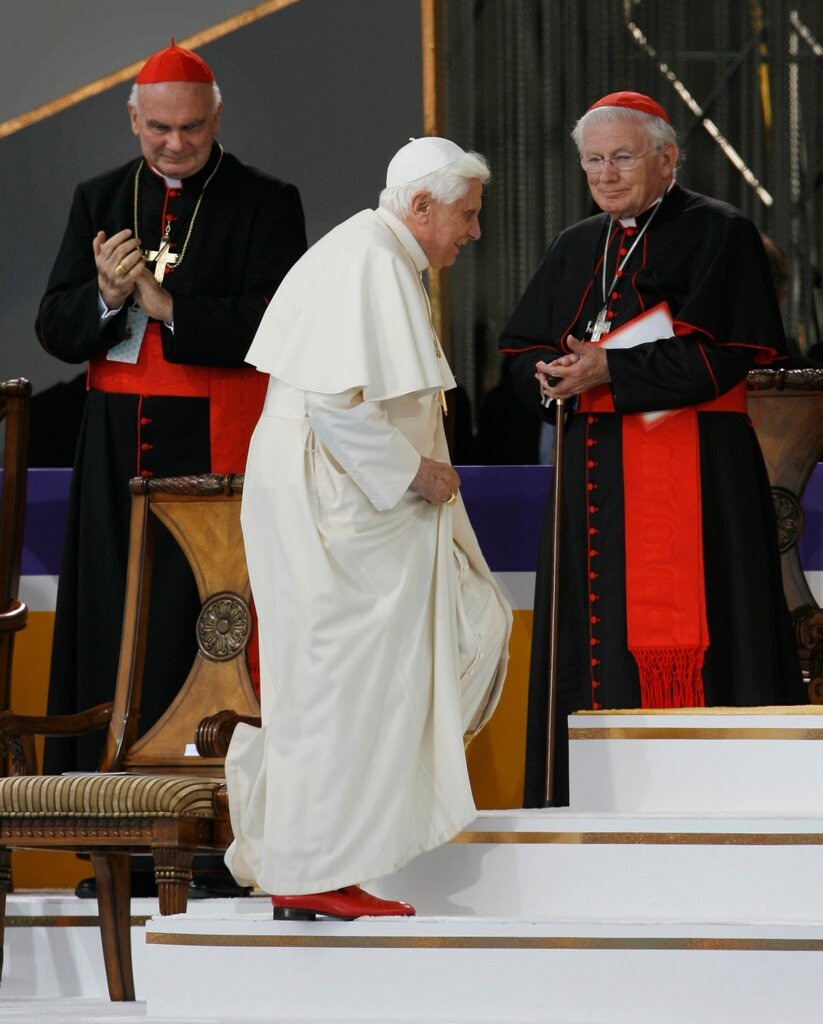
“When the Holy Father was elected, people were watching to see what he would do,” Bishop Madden said at a press conference the day of the announcement. “My appointment is an indication that one of the things the Holy Father had on his mind is Baltimore.”
Baltimore Cardinal William H. Keeler, Cardinal O’Brien and Archbishop Lori have all had opportunities to meet with Pope Benedict.
Cardinal Keeler, who was part of the College of Cardinals that elected Pope Benedict to lead the church, said in a 2005 interview with the Catholic Review that he always found the former Cardinal Ratzinger “very friendly, very supportive and very helpful.”
“I say that he reminds me of my mother: He is sweet and clear,” Cardinal Keeler said. The cardinal added that he found Pope Benedict “to be open to free discussion in his presence.”
“He is one who knows what the Catholic faith and its tradition are – and he’s able to articulate it with precision,” Cardinal Keeler said.
Historic day
During a Jan. 4 homily at an evening Mass held in memory of Pope Benedict XVI at the Cathedral of Mary Our Queen in Homeland, Auxiliary Bishop Adam J. Parker recalled being with Pope Benedict on the day he announced his historic resignation.
Then serving as priest-secretary to Cardinal O’Brien, Bishop Parker was among about 50 cardinals (including Cardinal O’Brien) and 15 others present for what was supposed to be a simple gathering to hear the pope announce the canonization of new saints.
When the pope started speaking in Latin following a brief prayer service at the Apostolic Palace, Bishop Parker wasn’t sure what was happening. As the German pontiff uttered the Latin word for “renounce,” however, Bishop Parker’s attention was piqued.

Following the pope’s three-minute address, Cardinal Angelo Sodano responded in more-familiar Italian, helping a bewildered audience realize that after some 600 years, a pope was resigning.
“I can tell you the shock was palpable,” Bishop Parker remembered. “After Pope Benedict left the room, having given us his blessing, the cardinals simply stood in stunned silence. No one knew what to say or what to do, or what would happen next, given that this hadn’t happened for so many centuries.”
Pope Benedict’s decision to step down was a mark of humility and wisdom – two virtues that characterized his entire pontificate, Bishop Parker said.
“Pope Benedict led the global Catholic Church with the humility of his conviction that Jesus alone has the words of everlasting life,” Bishop Parker said.
Email George Matysek at gmatysek@CatholicReview.org
Also see
Copyright © 2023 Catholic Review Media
